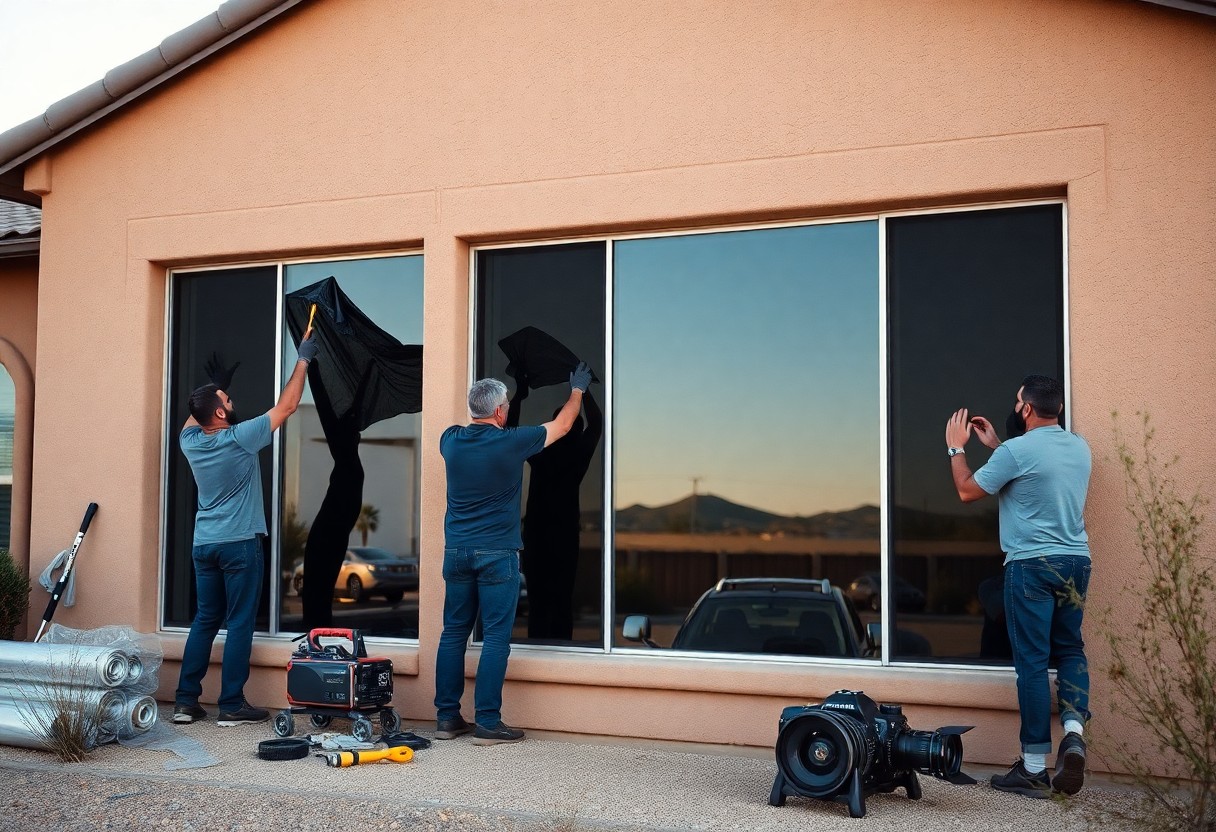Many homeowners in Maricopa seek effective ways to reduce energy costs and enhance comfort in their living spaces. By investing in window tinting, you can significantly improve your home’s energy efficiency. This practice not only limits heat gain from the sun, making your space cooler, but also reduces glare and protects your furnishings from UV damage. As a result, you’ll enjoy a more comfortable environment year-round, while simultaneously lower utility bills. Discover how window tinting transforms your home’s energy dynamics and makes a positive impact on your lifestyle.
Understanding Energy Efficiency
Energy efficiency plays a vital role in optimizing your home’s energy usage, leading to reduced bills and minimized environmental impact. By implementing various strategies and technologies, you can improve your home’s overall performance, ensuring that less energy is wasted and more savings are realized.
Definition of Energy Efficiency
Energy efficiency refers to using less energy to perform the same task or provide the same level of comfort or convenience, effectively reducing energy consumption without sacrificing quality or performance.
Importance in Residential Homes
In residential settings, energy efficiency translates into significant cost savings and increased comfort. By embracing energy-efficient practices, homeowners can mitigate escalating utility bills, enhance indoor air quality, and contribute to a sustainable environment.
For instance, homes equipped with energy-efficient appliances can consume up to 30% less energy compared to standard models. In Maricopa, where temperatures can soar, utilizing energy-efficient window tinting can prevent excessive heat gain and reduce the strain on your HVAC system. This not only preserves your home’s comfort but also plays a substantial role in lowering energy bills, achieving an eco-friendly footprint, and potentially increasing property value through enhanced efficiency features.
The Benefits of Window Tinting
Window tinting offers numerous advantages that significantly improve energy efficiency in your home. By reducing heat gain and glare, it helps you maintain a comfortable indoor environment while lowering energy bills. Additionally, with enhanced UV protection, window tinting safeguards your furnishings and skin, adding an extra layer of value to your investment. This multi-faceted solution not only boosts your home’s energy performance but also increases its overall appeal.
Heat Reduction
Heat reduction is one of the primary benefits of window tinting. By applying a quality tint, you can block up to 70% of solar heat entering your home, resulting in less reliance on air conditioning. This not only creates a more comfortable living space but also significantly lowers your energy costs, particularly during the sweltering summer months in Maricopa.
UV Protection
Window tinting also provides critical UV protection, blocking up to 99% of harmful ultraviolet rays from entering your home. This not only helps to preserve the integrity of your furnishings and flooring but also offers health benefits by decreasing your exposure to skin-damaging radiation. With extended protection, you can enjoy natural sunlight without the risks associated with UV exposure.
The importance of UV protection cannot be overstated. Over time, UV rays can fade and damage your interior, leading to expensive replacements or repairs. Moreover, prolonged exposure can increase the risk of skin conditions, including cancer. By investing in window tinting, you create a safer living space while extending the lifespan of your belongings, making it a worthwhile upgrade for any homeowner in Maricopa.
Types of Window Tinting
When selecting window tinting for your Maricopa home, you have several types to consider. Each one offers unique benefits and characteristics that contribute to overall energy efficiency.
- Dyed Film
- Metalized Film
- Ceramic Film
- Hybrid Film
- Safety and Security Film
Any of these options can significantly improve your home’s energy efficiency and aesthetic appeal.
| Type | Benefits |
|---|---|
| Dyed Film | Reduces glare, enhances privacy |
| Metalized Film | Reflects heat, increases durability |
| Ceramic Film | Excellent heat rejection, UV protection |
| Hybrid Film | Balanced performance, aesthetic appeal |
| Safety Film | Enhances security, shatter resistance |
Film Options
Choosing the right film type is crucial for maximizing energy savings. Each film option provides a unique set of features ranging from UV protection to glare reduction, allowing you to tailor the benefits to your specific needs. For instance, ceramic films offer superior heat rejection while maintaining excellent visibility, which can be particularly advantageous in hot climates like Maricopa.
Reflective vs. Non-Reflective
Reflective window films are designed to bounce back a large portion of the sun’s rays, while non-reflective films absorb heat. Reflective films are ideal for intense sunlight exposure, providing privacy and energy efficiency, whereas non-reflective options maintain a clear view without significant light alteration.
Reflective films often come in various shades and levels of reflectivity, impacting both aesthetics and functionality. For example, highly reflective films provide superior glare reduction and privacy during daylight but can make interiors feel darker. Non-reflective films, on the other hand, maintain a clearer view while still managing heat and UV exposure. Ultimately, your choice should align with your design preferences, energy-saving goals, and local climate conditions.

Installation Process
The installation process for window tinting generally involves several key steps to ensure a professional finish. Initially, a thorough cleaning of the windows is crucial to remove any dirt or dust. Once cleaned, precise measurements are taken to cut the film to size. You then apply the tint with a special adhesive while using tools to smooth out any bubbles. Proper curing time is vital to guarantee optimal adhesion and effectiveness. Your choice of installation, whether professional or DIY, can significantly impact the longevity and performance of the tint.
Professional vs. DIY
Choosing between professional installation and a DIY approach boils down to your experience and comfort level. Professionals bring expertise and tools, ensuring a flawless application that adheres to regulations and manufacturer warranties. Conversely, a DIY project can save you money but may result in potential errors, such as misalignment or bubbling. If you opt for DIY, familiarity with window films and adequate preparation are vital to achieving satisfactory results.
Factors to Consider
Several factors should influence your decision when installing window tint. Firstly, consider the type and quality of the tint film, as higher-quality options generally provide better durability and performance. Local regulations regarding tint darkness must also be observed, as they vary by state and can affect both aesthetics and compliance. Additionally, the climate in Maricopa can influence the film’s effectiveness in energy savings, so choose a tint designed for hot environments. Lastly, reflect on the long-term maintenance requirements of the tint you select.
- Type of film: prioritize quality to maximize benefits.
- Local regulations: ensure compliance with state laws.
- Climate considerations: select a tint suited for high temperatures.
- Maintenance: evaluate long-term upkeep demands.
- Professional help or DIY: weigh your skills against potential costs.
Understanding these factors allows you to make an informed choice and gather crucial information for your window tinting project. Since each decision can impact energy efficiency, aesthetics, and overall satisfaction, thorough research is important. Factors like expected longevity, warranty coverage, and even the visual appeal of the tint can significantly sway your final decisions. You’ll want to ensure every aspect melds well with your home and meets your personal standards.
- Ensure your chosen tint type aligns with your window style.
- Account for potential glare reduction benefits.
- Evaluate the aesthetic impact on your home’s exterior and interior.
- Seek expert opinions for the best outcomes.
- Explore energy savings estimates for your local climate and tint type.
Cost-Effectiveness
When considering energy efficiency improvements for your Maricopa home, window tinting stands out as a cost-effective solution. While the initial costs may seem steep, the potential for reduced energy bills makes it a wise long-term investment.
Initial Investment
The initial investment for professional window tinting can vary, typically ranging from $2 to $10 per square foot, depending on the type of film and installation complexity. However, investing in high-quality film ensures durability and effectiveness, ultimately enhancing your home’s comfort.
Long-Term Savings
Long-term savings from window tinting can significantly offset the initial costs. By blocking up to 99% of harmful UV rays and reducing heat gain, you can lower cooling costs by 30% or more, leading to substantial annual savings on energy bills.
For instance, if your monthly air conditioning bill is $200, window tinting could save you approximately $60 monthly, amounting to $720 annually. Over time, this means your investment in window tinting pays for itself within a few years, especially when combined with other energy efficiency upgrades. Furthermore, many brands offer warranties that ensure your investment is protected while continually decreasing your utility costs. This cumulative benefit makes window tinting not just a smart choice but a financially sound strategy for homeowners like you.
Local Regulations and Considerations
Understanding local regulations is vital when considering window tinting for your home in Maricopa. These regulations ensure that your choices comply with safety, aesthetic, and functional standards while enhancing energy efficiency. It’s imperative to familiarize yourself with both county laws and guidelines from neighboring areas to avoid any compliance issues.
Maricopa County Laws
In Maricopa County, window tinting must adhere to specific limits on visible light transmission, typically allowing no more than 35% tint on front windows. Additionally, reflective tints are limited to prevent excessive glare, ensuring safety for all road users. Be sure to check for any updates, as laws can change.
Neighboring Area Guidelines
Guidelines in neighboring areas might vary significantly, impacting your choices. Some municipalities enforce stricter regulations on tinting, with certain commercial areas requiring different standards compared to residential properties. For instance, cities like Scottsdale require a higher percentage of visible light transmission, potentially affecting the types of tints available to you.
Before finalizing your window tint, consider how adjacent communities enforce tinting standards. Local requirements in areas like Chandler or Tempe may specify maximum reflectivity percentages, which could limit your options. Engaging with local authorities or reviewing municipal codes can provide clarity on what is permissible, ensuring your energy efficiency improvements align with local guidelines and maintaining harmony with your neighborhood’s aesthetic. This diligence can save you from potential fines or reapplication costs in the future.
Summing up
Ultimately, by investing in window tinting for your Maricopa home, you enhance energy efficiency and create a more comfortable living environment. The insulation properties of window films reduce heat gain in summer and heat loss in winter, effectively lowering your energy bills and lessening the burden on your HVAC system. This not only benefits your wallet but also contributes to environmental sustainability. By choosing window tinting, you are making a smart decision for both your home and the planet.





